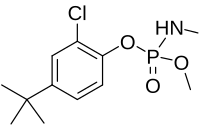
| |
| Names | |
|---|---|
| Preferred IUPAC name 4-tert-Butyl-2-chlorophenyl methyl N-methylphosphoramidate | |
| Identifiers | |
| CAS Number | |
| 3D model (JSmol) | |
| ChEBI | |
| ChemSpider | |
| ECHA InfoCard | 100.005.531 |
| EC Number |
|
| KEGG | |
| PubChem CID | |
| UNII | |
| CompTox Dashboard (EPA) | |
InChI
| |
SMILES
| |
| Properties | |
| Chemical formula | C12H19ClNO3P |
| Molar mass | 291.71 g·mol |
| Hazards | |
| GHS labelling: | |
| Pictograms |  
|
| Signal word | Warning |
| Hazard statements | H302, H312, H410 |
| Precautionary statements | P264, P270, P273, P280, P301+P312, P302+P352, P312, P322, P330, P363, P391, P501 |
| Except where otherwise noted, data are given for materials in their standard state (at 25 °C , 100 kPa). Infobox references | |
Crufomate is an insecticide.
Potentially toxic to humans, the National Institute for Occupational Safety and Health has set a time-weighted average exposure limit of 5 milligrams per cubic meter, with a short-term limit of up to 20 milligrams per cubic meter for brief exposures of no longer than 15 minutes.
Routes of exposure to crufomate include inhalation, eye contact, skin absorption, and ingestion. Symptoms include eye irritation, loss of appetite, nausea, diarrhea, abdominal cramps, perspiration, lacrimation, blurred vision, dyspnea, wheezing, and respiratory and skin irritation. First aid measures include artificial respiration to treat inhalation exposures, eye irrigation for eye exposures, and immediate washing with soap for skin exposure. Immediate medical attention should be sought if crufomate is swallowed.
References
- Pubchem. "Crufomate | C12H19ClNO3P - PubChem". pubchem.ncbi.nlm.nih.gov. Retrieved 2016-05-20.
- ^ "CDC - NIOSH Pocket Guide to Chemical Hazards - Crufomate". Centers for Disease Control and Prevention. 11 April 2016. Retrieved 20 May 2016.